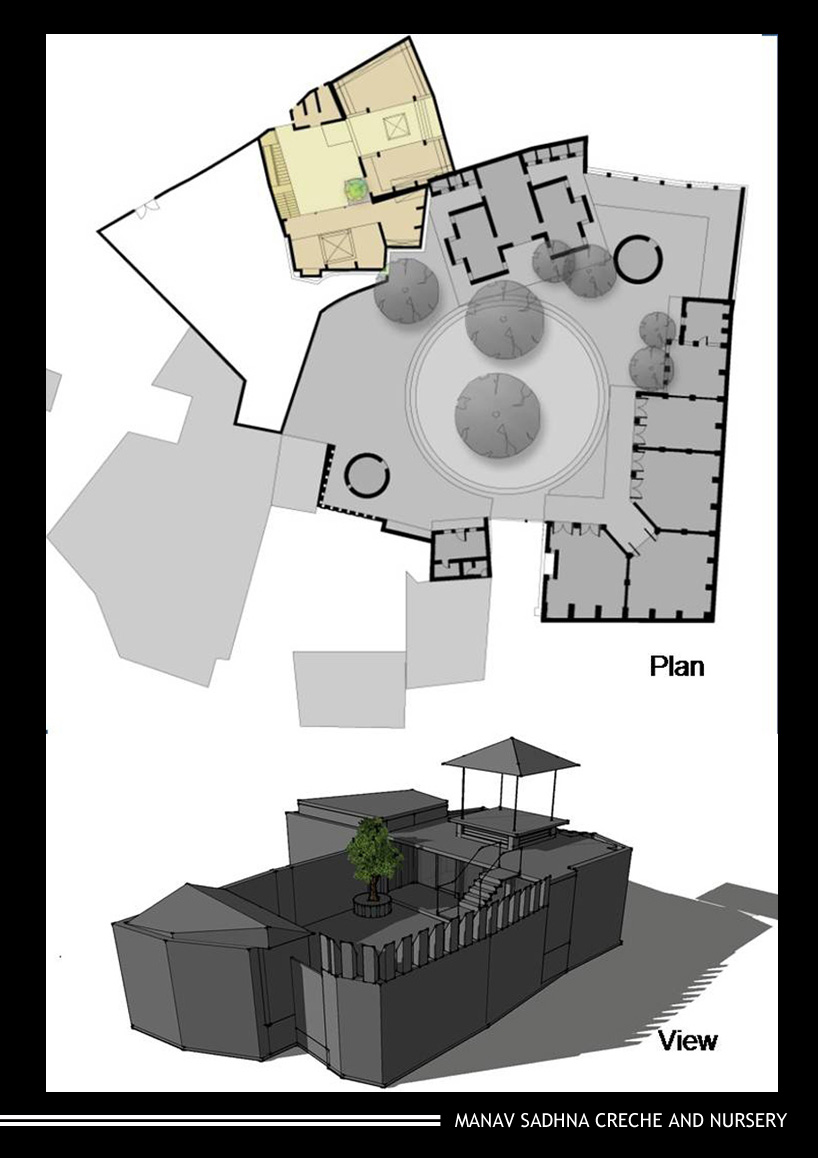
manav sadhna creche and nursery by Yatin Pandya from india
designer's own words:
Manavsadhna is a social NGO that engages in the service of humanity. Addressing the issue of educating while employing the slum children, it created an activity centre in the middle of squatter settlement which operates as an informal school in the morning. Afternoon it trains the youth with vocational skills for better employability. Evening it transforms into community centre with sports, leisure, gymnastics as well as social gathering. This multi use centre was created as a demonstration of the indigenously developed and locally produced building components created by recycling the domestic and municipal waste. This meant reduction in waste thrown thereby reduction in environmental pollution. Employment and empowering of the urban poor as value addition processes of converting waste into building components create economic opportunities without needing capital intensive, mechanised or centralised production setup. The building components thus produced are, cheaper and better performing than the conventional alternatives readily employed, as a result their housing can also become affordable and better in quality.
In an adjoining plot another centre has now been added for the purpose of crèche. Young children in slum areas have problem of being looked after through the day when both parents are out at work for earning livelihood. Manavsadhna crèche is identified as an answer to this very critical issue. The locally employed women serve as ‘nanny’ through the day to couple of dozen slum kids. The place functions as a cradle house, play area, nursery school as well as community facility centre for bathing and personal hygiene of young children. It also has a provision for overnight stay of the volunteers.
The place is essentially conceived as a traditional khadki- a residential precinct with closable courtyard to which all peripheral spaces open. The courtyard door, if open, makes the campus externally oriented to interface with street, while by choice if shut can make it introverted yet outdoor space where young children can safely play and rest without noise. Mothers get their privacy while breastfeeding. So it becomes a versatile place where indoors spill outdoors and outdoors translate into an open room. Fully openable pivoted doors to the room mark inside to outside transition seamless. It also offers the choices of scale and type of spaces to adopt by activities, seasons or the time of the day. Room walls essentially are the retaining wall structures to the adjoining plot which occur at the higher levels. The roof’s flat plane, as terrace, becomes the natural extension of the ground at the upper level to neighbouring plot. Pyramidical translucent roof pavilion on the raised central slab becomes the stage for outdoor social events of the activity centre.
The built spaces get insulated from at least three sides by earth mass or the adjoining structure while the fourth open to deep veranda space. Brick piers of the peripheral retaining walls get consumed as storage voids. Deep seated perforated shutters of the rooms work as inlets of cooler air through shaded veranda while raised central bay provides for escape chimney through glazed ventilators and hence, natural cross ventilation. Skylights on the edge walls wash off the light on wall planes to bring in illumination without a glare of the direct sun. Stained glass bottles embedded in the slab also serve as the same.
In continuation of the explorations for the recycling of waste at Manavsadhna activity centre, here at the crèche the experimentation is done with the palette of waste material found from the other construction site. Some one’s waste becomes some one’s resource. The walls are made out of the fly ash non burnt bricks which is stronger and cheaper than the conventional burnt clay bricks in addition to them being pollution friendly by using the thermal PowerStation’s waste. The flooring is a creative collage of range of scrap material such as recycled mosaic tiles, variety of residual stone strips as well as terrazzo. The flooring pattern in the hall for the children creates educative as well as interactive flooring by local mason and craftsman based detailing. For example not only the waste residues of the tiles and stones are resized to bring in aesthetic pattern through their creative repetition but in the centre there is a constellation of living planet created with shaped profiles of the Sun, Moon, bird, flower, animal, reptile etc. The flooring for the volunteer’s space has semi dressed stone strips to create patterns of palm trees, leaves and floral abstractions. Roof and ceiling has been experimented with number of materials. As filler slab it has an infill of sporadic glass bottle cluster to also bring in the glow of light. The other filler material chosen has been sundried clay bowls which are being produced by the neighbouring potters as business proposition. One more such filler has been the computer key boards which not only provide texture to ceiling but also makes it visually engaging as well as educative with alphabets on them for a child watching the ceiling lying on floor. Ceiling is further animated by the help of local women who skilfully rendered it with filigree in bright colours. The end wall also has been animated with mud mirror craft of the province. These initiatives also bring in sense of involvement and belonging in the inhabitants. The outer wall of the courtyard is painted with combination of floral motifs and caricatures. Court is further animated by the stair and slide combination on the opposite edge. Stair connecting the activity centre at the terrace level splits at the landing to become playful slide for the children. Stair railing and parapet also has been designed from the metal scrap received from other sites. Doors have been one of the most interactive and dynamic elements of the space. Made up of steel frame and recomposed metal parts as infill. The diverse parts of broken bicycles and used rotary blades of stone cutter etc have been creatively composed which not only is like a grill to door’s shutters but creates dynamic backdrop to the space with silhouette profiles and multiple sub patterns within the component assembly. The dynamism is further enhanced by actually moving wheels as well as sound chimes within the door. This also alerts other faculties of the child in addition to sight.
As most families in slum are deprived of basic sanitation facilities at home the crèche playfully provides for bathing under a water spout, through recycled bathtub embedded in ground
The Stage pavilion on the roof terrace is made up of light weight Fibre Reinforced plastic but is strengthened as well as brightened up with colourful cloth rags sandwiched within FRP.
The sum total of these have rendered flexible, functional, cheerful and sustainable space with alchemy of the built and un built, waste material and skilled craftsmanship, Environment and aesthetics as well as constrains and creativity.
Plan representing flexible layout allowing for multipurpose activities.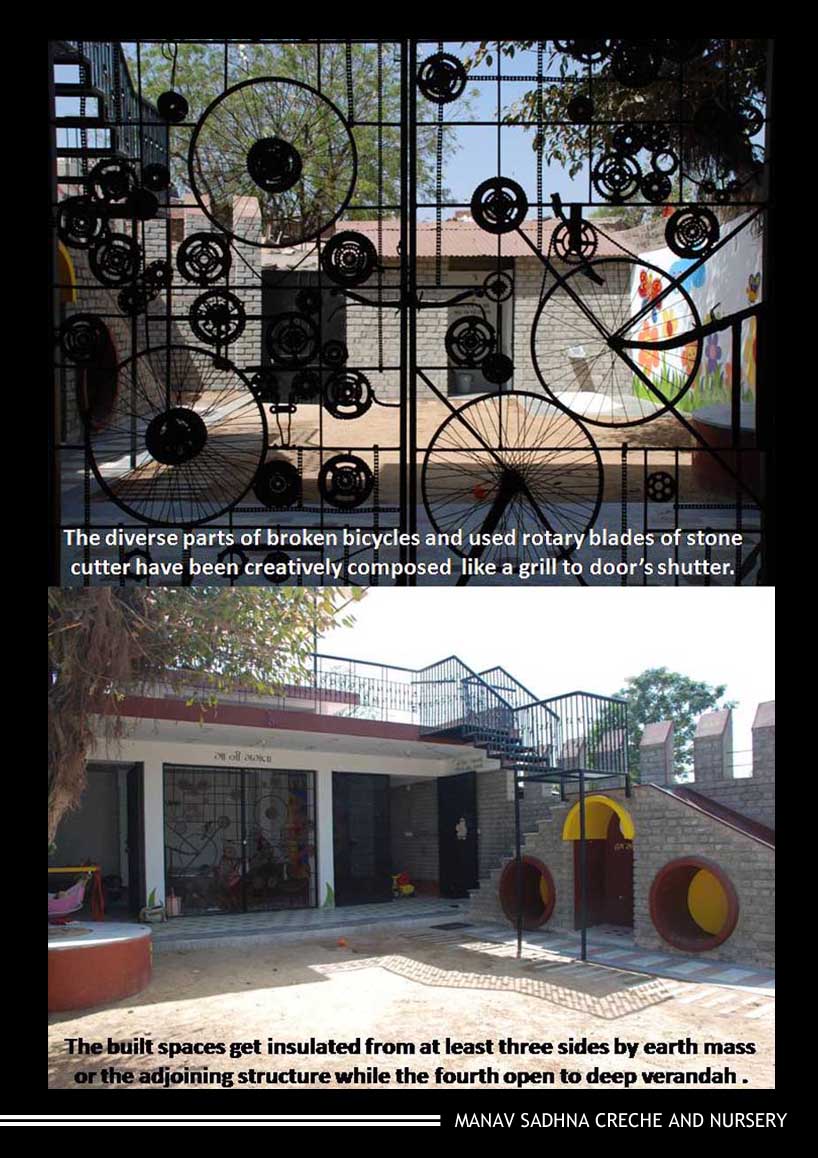 1.The diverse parts of broken bicycles and rotary blades of stone cutter have been creatively composed like a grill to door’s shutter. 2. The built spaces get insulated from atleast three sides by earth mass or the adjoining structure while the fourth open to deep verandah.
1.The diverse parts of broken bicycles and rotary blades of stone cutter have been creatively composed like a grill to door’s shutter. 2. The built spaces get insulated from atleast three sides by earth mass or the adjoining structure while the fourth open to deep verandah. 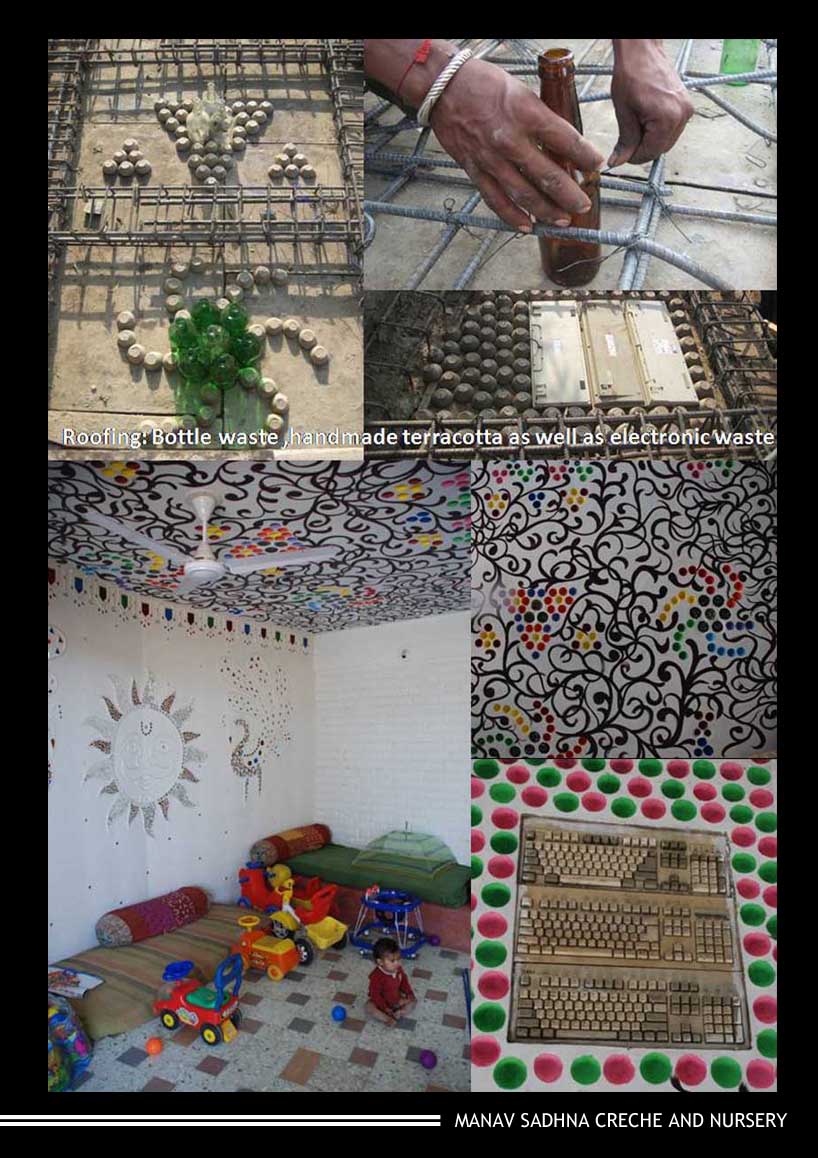 Roofing : bottle waste, handmade terracotta as well as electronic waste.
Roofing : bottle waste, handmade terracotta as well as electronic waste.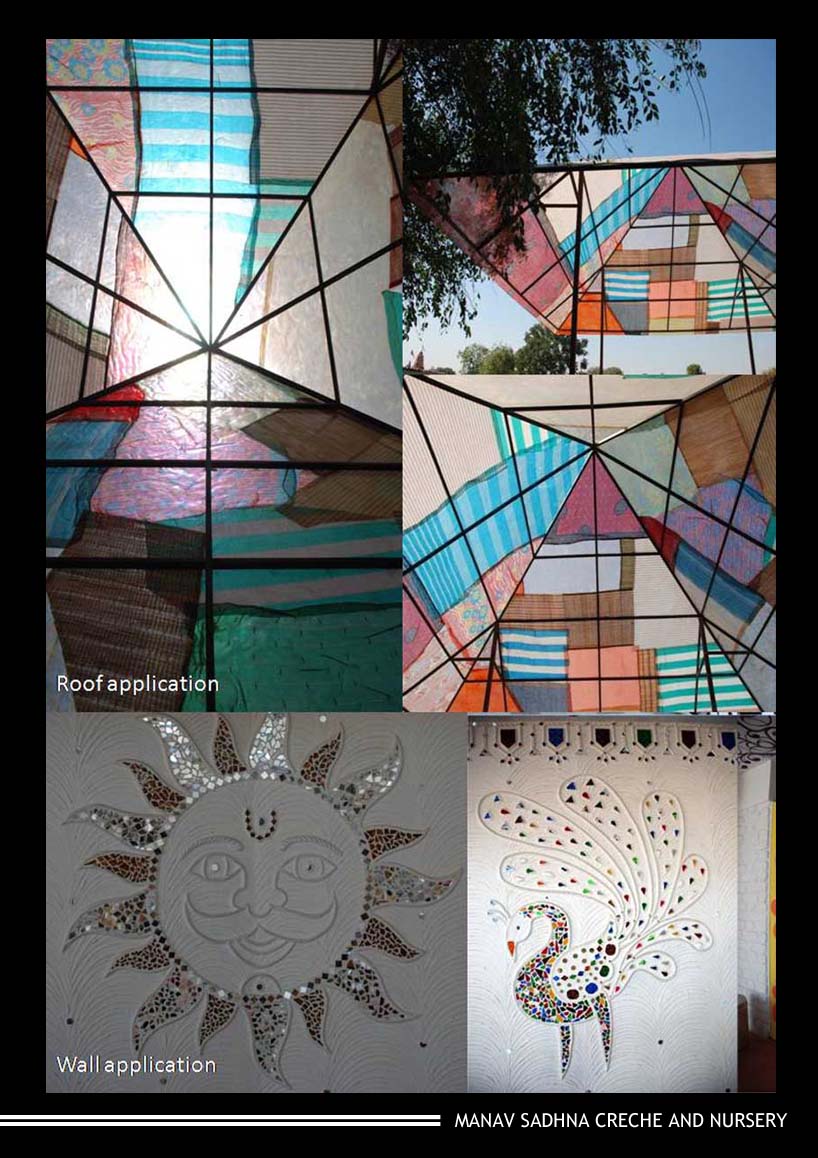 Roof and wall application.
Roof and wall application.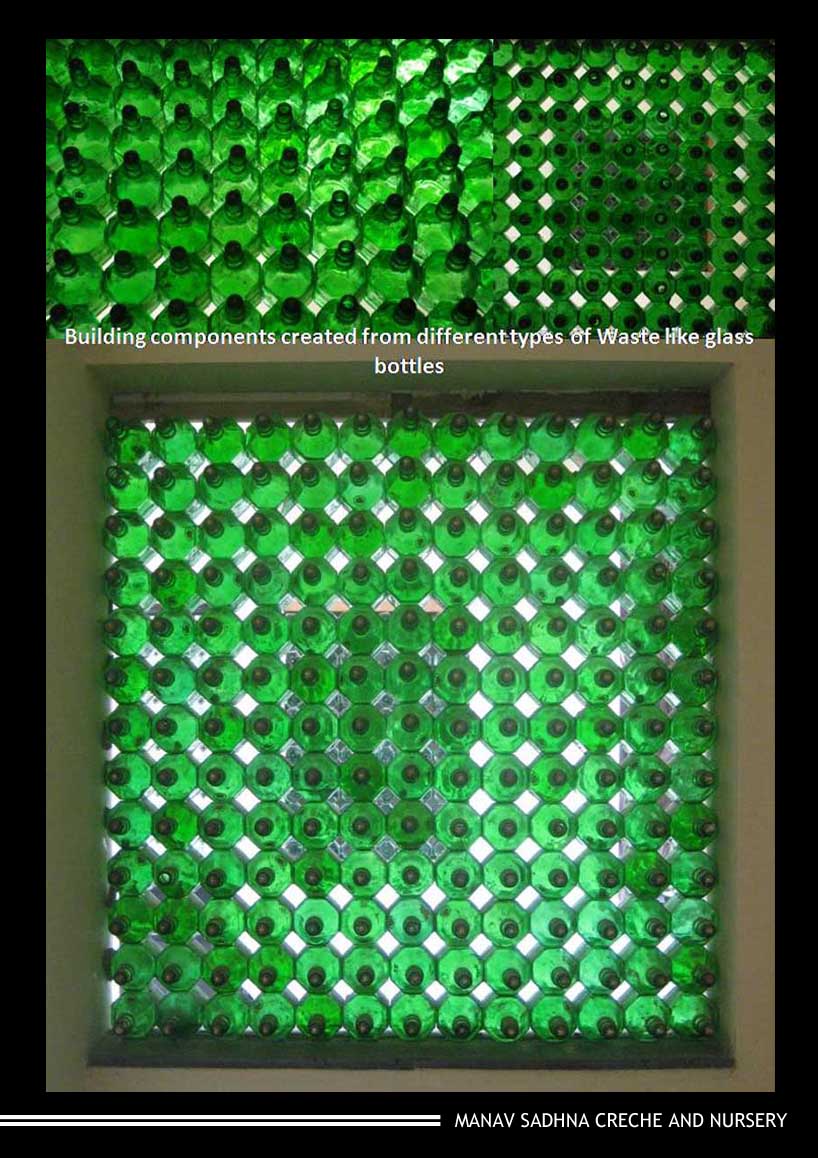 Building components created from different types of waste like glass bottles.
Building components created from different types of waste like glass bottles.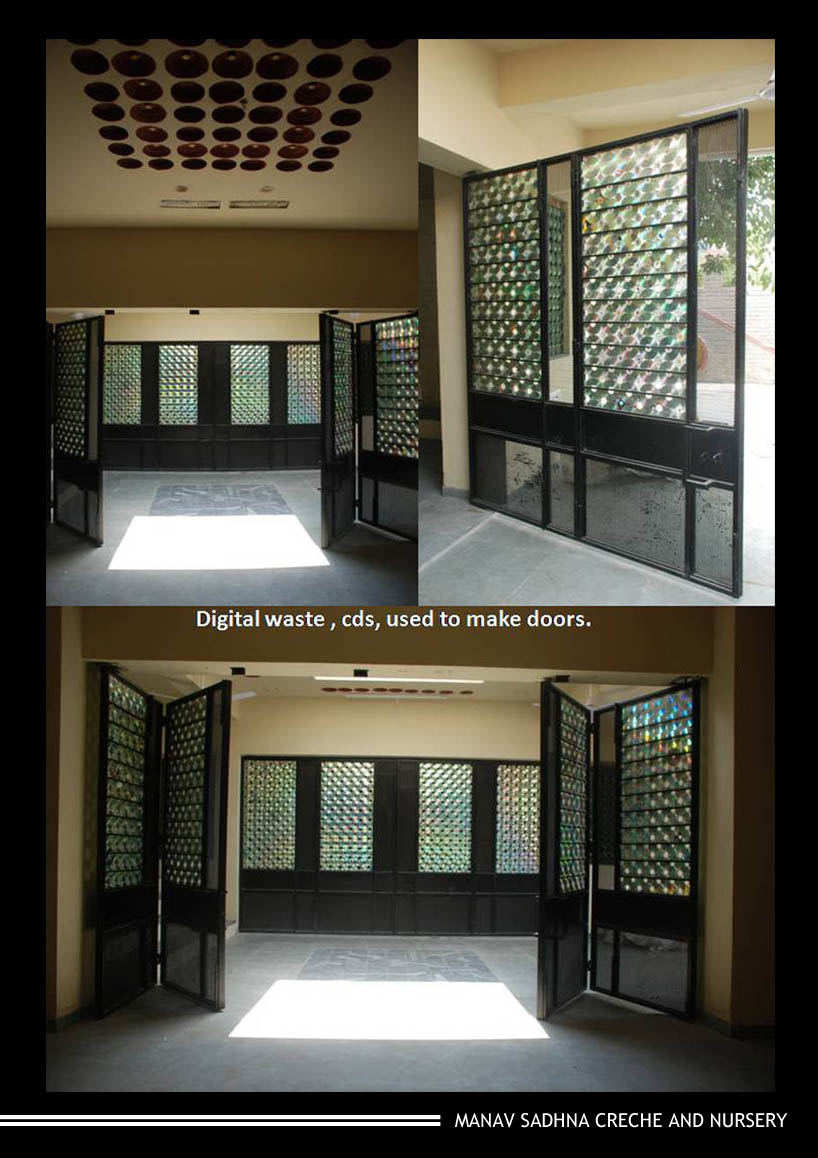 Digital waste, cd’s used to make doors.
Digital waste, cd’s used to make doors.